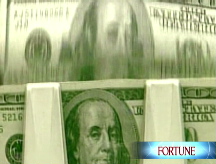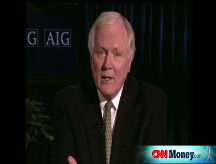Where the bailouts stand
Every day brings more news about the government's efforts to fix the economy. Here is how the plans are taking shape.
NEW YORK (CNNMoney.com) -- The government's $700 billion bailout efforts are well underway. It has committed 70% of the first pile of money -- $250 billion and 40% of a second batch of $100 billion.
Still more bailouts are in the air, and Treasury Secretary Henry Paulson said Wednesday the government would broaden the reach of the $700 billion bailout plan to support non-bank financial institutions.
So far, the government has pledged about $172 billion of that $250 billion to a total of 52 banks, according to Keefe, Bruyette & Woods. That total may actually be higher, since the Treasury is relying on the banks to announce their participation in the program.
Under the Troubled Asset Relief Program (TARP), the Treasury has already sent $125 billion to nine major banks, with JPMorgan Chase (JPM, Fortune 500), Citigroup (C, Fortune 500) and Wells Fargo (WFC, Fortune 500) leading the pack with $25 billion in federal funding.
The 43 remaining banks have been approved for a total of $47 billion in TARP funds, but have not yet received the checks. Paulson said the Treasury is moving quickly on that front, but it will "take time to complete legal contracts and executive investments" for the dozens of eligible banks.
That leaves the Treasury with, at most, $78 billion left in the first round of funding. But the government won't just give the money out - banks have to appeal to the Treasury for TARP money.
For the second round of funding, President Bush asked Congress for $100 billion more of the $700 billion approved for the bailout. The Treasury spent $40 billion of that second round funding Monday on insurer AIG (AIG, Fortune 500), as part of a restructured bailout deal for the troubled company.
The Treasury would have to go back to Congress for the remaining $350 billion. Paulson said Wednesday there is no "timeline" for asking lawmakers for that authority.
The purchase of toxic mortgage-backed securities is how the Treasury first sold Congress on the proposal, but Paulson said the government is no longer planning to purchase illiquid mortgage assets, as it "is not the most effective way to use TARP funds.
On top of the first $250 billion, the next $100 billion appears to be aimed at non-bank financial institutions and other businesses. AIG has already received $40 billion TARP funds.
There's a growing chorus of voices outside of Treasury to spread bailout money around.
The recent struggles of GM (GM, Fortune 500), Ford (F, Fortune 500) and Chrysler have built momentum for a bailout of the U.S. auto industry. President-elect Barack Obama, House Speaker Nancy Pelosi, D-Calif., and Senate Majority Leader Harry Reid, D-Nev., all threw their support behind such a move.
And some government officials like FDIC Chairwoman Sheila Bair have called for TARP money to be used to guarantee mortgages backed by private lenders to encourage them to restructure loans to troubled homeowners. The Bush administration's new program to modify mortgages announced Tuesday stopped short of providing direct government financial help.
Here is how the government has thus far invested billions of dollars to rescue banks, companies, consumers and their homes.
The government has taken these steps to aid financial institutions.
Term-auction facility: $1.5 trillion in loans to banks so far in exchange for otherwise unwanted collateral. The Fed increased its monthly auction limit to $300 billion in October, up from $20 billion when the Fed began the program.
Dollar swap lines: Unlimited dollars to 13 foreign central banks to provide liquidity to foreign financial institutions. The Fed lifted its cap after raising it to $620 billion in October from $24 billion in December.
Bear Stearns: $29 billion in a special lending facility to guarantee potential losses on its portfolio. With the lending facility, JPMorgan was able to step in to save Bear from bankruptcy.
Lending to banks: $77 billion lent on average every day to investment banks, after facility opened to non-commercial banks for first time in March.
Cash injections: $250 billion to banks in exchange for equity stake in the financial institutions in the form of senior preferred shares.
Mortgage-backed securities purchases: Up to $410 billion allotted to purchase troubled assets from banks.
Fed rate cuts: Down to 1% in October 2008, from 5.25% in September 2007.
Consumers are benefiting from the government's actions in recent months.
Stimulus checks: $100 billion in stimulus checks made their way to 140 million tax filers to boost consumer spending and help grow the economy.
Unemployment benefits: $8 billion toward an expansion of unemployment benefits, to 39 weeks from 26 weeks.
Bank takeovers: $13.2 billion drawn down so far from the FDIC's deposit insurance fund after 19 bank failures in 2008.
Rehab foreclosed homes: $4 billion to states and municipalities in assistance to buy up and rehabilitate foreclosed properties.
Student loan guarantees: $9 billion so far in government purchases of student loans from private lenders. Higher borrowing costs made student loans unprofitable for a number of lenders, many of whom stopped issuing the loans.
Money-market guarantees: $50 billion in insurance for money-market funds. The Fed then began to lend an unlimited amount of money to finance banks' purchases of debt from money-market funds. The Fed then agreed to purchase up to $69 billion in money-market debt directly. In October, the Fed said it would loan up to $600 billion directly to money-market funds.
Housing rescue: $300 billion approved for insurance of new 30-year, fixed-rate mortgages for at-risk borrowers. The bill includes $16 billion in tax credits for first-time home buyers. But lenders have been slow to sign on.
Deposit insurance: $250,000 in insurance for interest-bearing accounts, up from $100,000. The FDIC also issued unlimited guarantees on non-interest- bearing accounts and newly issued unsecured bank debt.
Uncle Sam has intervened to help companies in the following ways.
Business stimulus: $68 billion in tax breaks to corporations to help loosen the stranglehold on businesses trying to finance daily operating expenses.
Fannie Mae, Freddie Mac: $200 billion to bail out the mortgage finance giants. Federal officials assumed control of the firms and the $5 trillion in home loans they back.
AIG: $152.5 billion restructured bailout, including a direct investment through preferred shares, a easier terms on a $60 billion loan, and new facilities meant to take on the companies exposure to credit-default swaps.
Automakers: $25 billion in low-interest loans to speed the industry's transition to more fuel-efficient vehicles.
Commercial paper facility: $243 billion in corporate debt purchased so far by the Fed since its so-called Commercial Paper Funding Facility opened. ![]()



